The Allegorical Mother
Character Type in
Astrology
Cancer is the Zodiac sign of the benefactor, who cares for others even at great personal cost, devoting his or her life to the well-being of those closest, particularly the family. It’s the Archetype of the Mother, who nurtures and protects the ones in her care.
The painting above was made in 1663 by Elisabetta Sirani (1638-1665), who is one of the few women recorded in art history previous to the 19th century. The motif is a classic: Mother Mary and the infant Jesus. The Messiah to be in the loving care of his earthly mother. In Christian culture through the many centuries, this is the archetypical image of the mother.
Without the motherly womb and her years of nurturing, none of us would be.
Considering the many symbols of rich and deep meaning, there’s no wonder this motif has been such a popular one. Below is another example, a painting by the most famous artists of them all: Leonardo da Vinci. This time the mother is doubled: also Mary’s own mother St. Anne participates, by which the continuous chain of being is pointed out.
Mankind emerges from the wombs of all those generations of mothers, the cycle of reproduction since the dawn of our species.
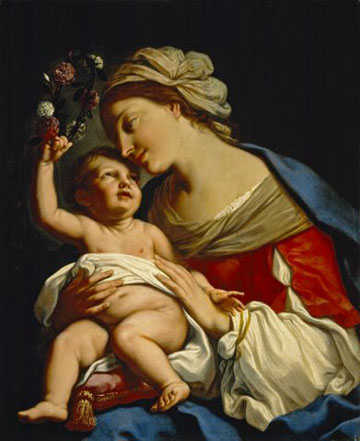
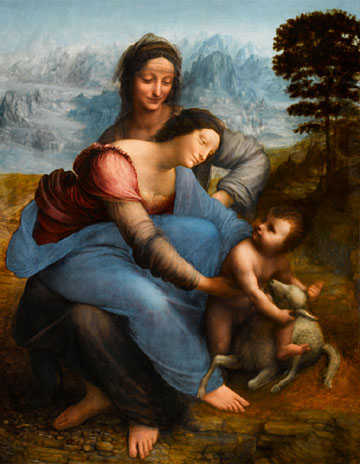 The Virgin and Child with St. Anne, the mother of Mary, by Leonardo da Vinci. He worked on it for several years, but it remained in his workshop, as if unfinished, until his death in 1519. This is how the painting looks after the recent restoration, which has met with a lot of controversy. The same painting before the restoration is here.
The Virgin and Child with St. Anne, the mother of Mary, by Leonardo da Vinci. He worked on it for several years, but it remained in his workshop, as if unfinished, until his death in 1519. This is how the painting looks after the recent restoration, which has met with a lot of controversy. The same painting before the restoration is here.
Being that devoted mother is not always a picnic. When you commit totally to someone, your emotions are at risk. The most terrible example of this is the unnatural monstrosity when parents survive their child.
Child mortality was steep all through history, up until the last hundred years or so. Therefore, countless parents have experienced that trauma. Again, Mother Mary is the archetypical symbol, since fate had her watch the execution of her son. This motif, in art history called pietà (pity), usually shows the dead Christ cradled by his grieving mother. The most famous example is that of Michelangelo’s sculpture.
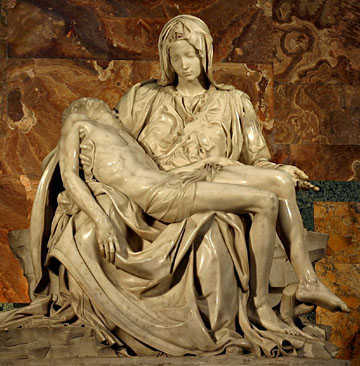
Pietà, by Michelangelo 1499.
The most ancient and dominant of mother images through history, though, is that of the fertile woman in care of our reproduction.
In Greek mythology there is Gaia, whose name simply means Earth. She was the very first mother, giving birth to titans and gods, as well as the world we inhabit. She was Mother Earth. Another example is Eve, the first woman according to the Bible, from whose womb we all stem. In modern genetics, there is a Mitochondrial Eve in Africa some 200,000 years ago, from whom every Homo Sapiens descends.
One of the oldest pieces of art found is a little sculpture of a woman, circa 25.000 years old. It’s called Venus of Willendorf, after the place where she was found – and after the goddess of love and fruition, of which she seems to be an older example.
The shape of her body, with enhanced breasts and abdomen, is surely intended to magnify her as an image of fertility. She is the mother able to bear and nourish numerous children. Archaeologists have found several similar sculptures.
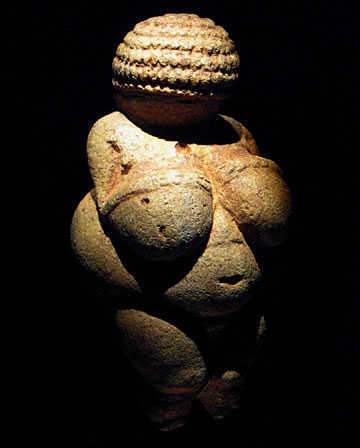
Venus of Willendorf. Sculpture from c. 24,000-22,000 BC.
No doubt, the mother is one of the most central and important of the archetypes – if not the foremost and primordial one. True, just about all the creation myths that have a primordial creator deity make him male, although that would be a leap of imagination even to primordial man. In spite of this, no culture has been unaware of the central stage of life being occupied by the gender of its major procreator.
This fundamental importance of the mother is also expressed in the astrological meaning of the Cancer sign: its compassion is not optional, neither to itself nor to its surrounding. The sign is a cardinal one. Cancer will take care of others, whether they want it or not. The mother is not a servant, but a ruler. She is sure she knows what’s best, so in her care she is decisive, demanding, and non-compromising.
This is implied in most mythologies, where female deities are in no way easier to please and appease than the male ones. In contemporary myth, especially in the USA, there’s the image of the Jewish mother, overprotective and persistent. Not to mention the assumptions about any mother-in-law.
The over-the-top mother, never releasing her children from the parental chains, is no stranger to fiction, nor to history. Sometimes it went terribly awry.
Imperial Rome was a stage for many dramas surpassing fiction. It also had its share of mothers running amok. One often mentioned is Livia Drusilla, longtime wife of Emperor Augustus and mother of Tiberius, who was to be the next emperor. She was indeed someone to reckon with in Ancient Rome, but her Machiavellian character was mostly an invention of the 20th century writer Robert Graves in his novel I, Claudius, which also became a successful TV-series.
But we don’t have to go far from Livia Drusilla for a splendid example of a maternal monster. Livia was the great grandmother of Agrippina the Younger (15-59 CE), who was the sister of Emperor Caligula, the wife of Emperor Claudius, and mother of the infamous Emperor Nero. This feisty woman was suspected to have killed her husband, among others, and to have been killed by her son. Although she died already at the age of 43, she had time for a lot of intense drama forever etched into the history books.
Her venomous actions were only surpassed by those of her son, whom she had done just about all to guarantee the Empire. At least, she escaped the terror of having to survive her offspring.
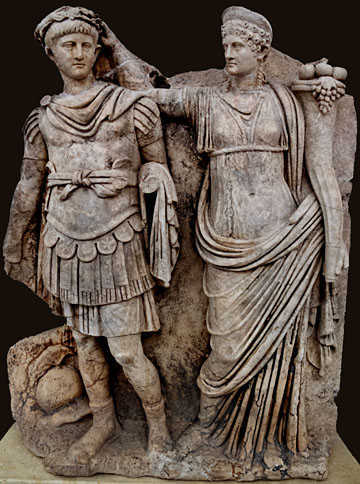
Emperor Nero and his mother Agrippina the Younger. Sculpture from c. 54-59 CE.
But of course, the main symbol of the mother is that of bringing life instead of ending it. The archetype is one of giving birth to children and nurturing them, as long as she or they live.
Zodiac Archetypes
![]()
Archetype is a concept familiar already to Ancient Greece, where it was called archetupon and meant “first-moulded” – like a prototype. Plato had theories about mental ideas – or forms – that were imprinted in the human mind before birth.
The psychoanalyst C. G. Jung claimed that there is a number of archetypes that we all share, without necessarily having been taught them. They’re part of what he called our collective unconscious and influence how we look at reality. He also meant that the archetypes as inner clues to self-realization.
I’ve written more about C. G. Jung’s theory on archetypes here:
Jung’s Archetypes
The twelve signs of the Zodiac can fruitfully be seen as a system of archetypes, making a complete world of sorts – let’s say the cast of characters needed to make a play that represents human life sort of completely. The twelve characters can be seen as separate individuals making up the variety that mankind offers, or they can represent the different aspects and potentials of any one single person.
Here is more about the archetypes and how to apply them to the Zodiac signs:
Zodiac Archetypes
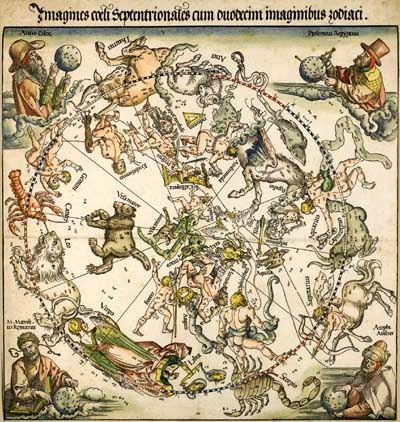
The Zodiac Star Constellations, by Albrecht Dürer.
